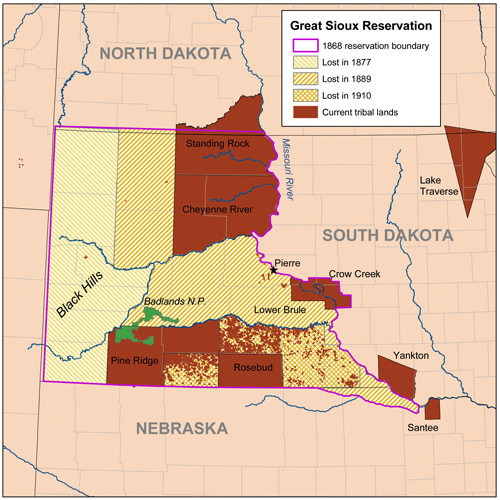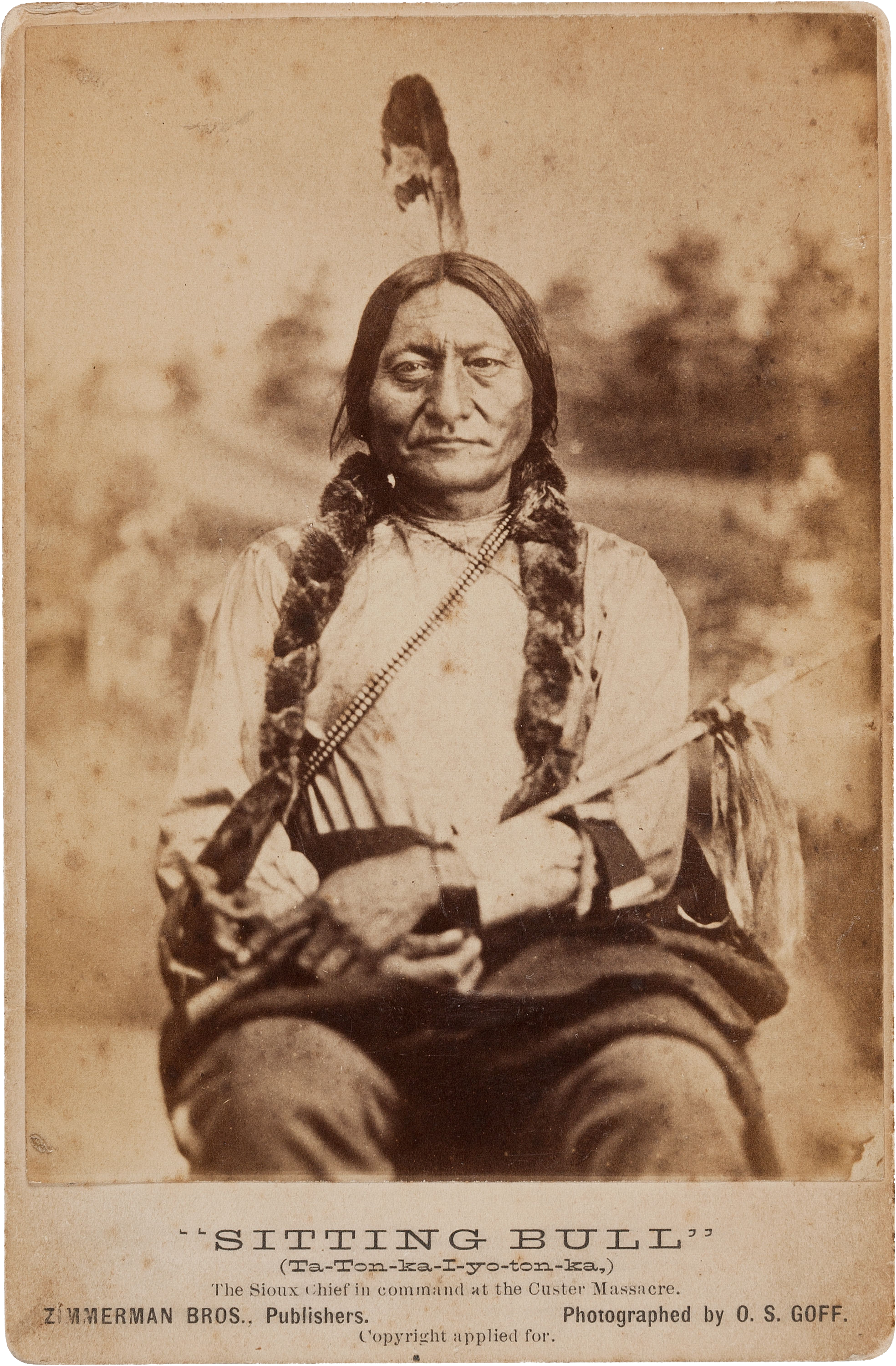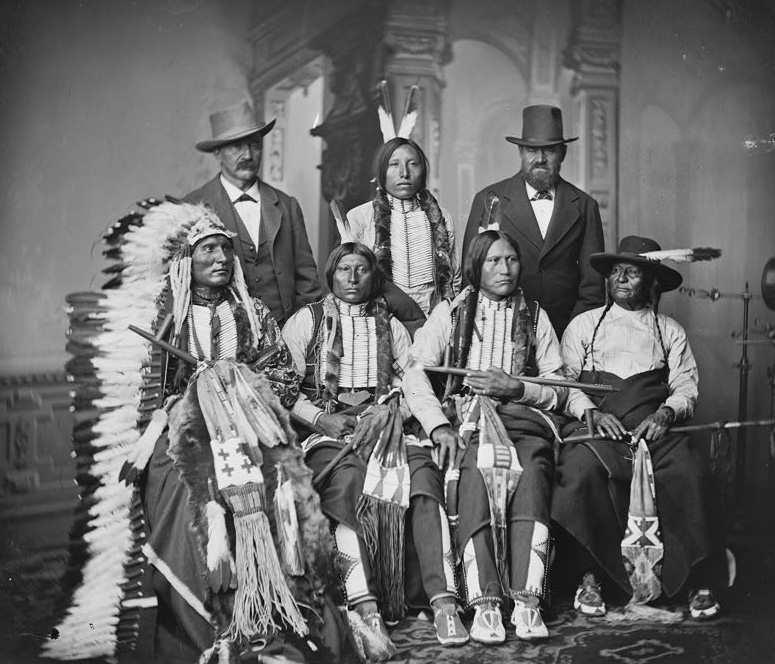|
Paul Swan
Paul Swan (Lakota: Maǧáska, 1838? – September 30, 1900) was a prominent Minneconjou Lakota headman on the Cheyenne River Reservation. Early life Born about 1838, he was the son of the influential headman Chief White Swan, one of six hereditary chiefs of the Minneconjou (a.k.a. Howoju or Owoju) 1866. White Bull later recalled that the elder White Swan "in particular hated the whites." By the time of the Great Sioux War of 1876-77, however, White Swan's position had moderated and he had settled at the Cheyenne River Agency on the Missouri River. His sons, however, including Paul Swan a.k.a. Little Swan, Fine Weather and Puts on His Shoes, remained out with the non-treaty bands. Paul fought at the Battle of Rosebud and the Battle of the Little Bighorn. Following the death of his father in 1877, Paul Swan assumed the leadership role of his family band. Cheyenne River Reservation It is uncertain when Paul Swan and his brothers surrendered at the Cheyenne River Agency. They may hav ... [...More Info...] [...Related Items...] OR: [Wikipedia] [Google] [Baidu] |
Minneconjou
The Miniconjou (Lakota: Mnikowoju, Hokwoju – ‘Plants by the Water’) are a Native American people constituting a subdivision of the Lakota people, who formerly inhabited an area in western present-day South Dakota from the Black Hills in to the Platte River. The contemporary population lives mostly in west-central South Dakota. Perhaps the most famous Miniconjou chief was Touch the Clouds. Historic Miniconjou thiyóšpaye or bands Together with the Sans Arc (''Itázipčho'', ''Itazipcola'', ''Hazipco'' - ‘Those who hunt without bows’) and Two Kettles (''Oóhe Núŋpa'', ''Oóhenuŋpa'', ''Oohenonpa'' - ‘Two Boiling’ or ‘Two Kettles’) they were often referred to as ''Central Lakota'' and divided into several ''bands'' or ''thiyóšpaye'': * Unkche yuta (‘Dung Eaters’) * Glaglaheca (‘Untidy’, ‘Slovenly’, ‘Shiftless’) * Shunka Yute Shni (‘Eat No Dogs’, split off from the ''Wanhin Wega'') * Nige Tanka (‘Big Belly’) * Wakpokinyan (‘Fl ... [...More Info...] [...Related Items...] OR: [Wikipedia] [Google] [Baidu] |
Cheyenne River Reservation
The Cheyenne River Indian Reservation was created by the United States in 1889 by breaking up the Great Sioux Reservation, following the attrition of the Lakota in a series of wars in the 1870s. The reservation covers almost all of Dewey and Ziebach counties in South Dakota. In addition, many small parcels of off-reservation trust land are located in Stanley, Haakon, and Meade counties. The total land area is 4,266.987 sq mi (11,051.447 km²), making it the fourth-largest Indian reservation in land area in the United States. Its largest community is unincorporated North Eagle Butte, while adjacent Eagle Butte is its largest incorporated city. Land status The original Cheyenne River Reservation covered over 5,000 sq. mi. The reservation has subsequently decreased in size; today it is 4,266.987 sq mi (11,051.447 km²). The original northern boundary was the Grand River. However, in the early 20th century, land south of the Grand River was ceded to the Standi ... [...More Info...] [...Related Items...] OR: [Wikipedia] [Google] [Baidu] |
Great Sioux War Of 1876-77
The Great Sioux War of 1876, also known as the Black Hills War, was a series of battles and negotiations that occurred in 1876 and 1877 in an alliance of Lakota Sioux and Northern Cheyenne against the United States. The cause of the war was the desire of the US government to obtain ownership of the Black Hills. Gold had been discovered in the Black Hills, settlers began to encroach onto Native American lands, and the Sioux and the Cheyenne refused to cede ownership. Traditionally, American military and historians place the Lakota at the center of the story, especially because of their numbers, but some Native Americans believe the Cheyenne were the primary target of the American campaign. Among the many battles and skirmishes of the war was the Battle of the Little Bighorn; often known as Custer's Last Stand, it is the most storied of the many encounters between the US Army and mounted Plains Indians. Despite the Indian victory, the Americans leveraged national resources to fo ... [...More Info...] [...Related Items...] OR: [Wikipedia] [Google] [Baidu] |
Battle Of Rosebud
The Battle of the Rosebud (also known as the Battle of Rosebud Creek) took place on June 17, 1876, in the Montana Territory between the United States Army and its Crow and Shoshoni allies against a force consisting mostly of Lakota Sioux and Northern Cheyenne Indians during the Great Sioux War of 1876. The Cheyenne called it the Battle Where the Girl Saved Her Brother because of an incident during the fight involving Buffalo Calf Road Woman. General George Crook's offensive was stymied by the Indians, led by Crazy Horse, and he awaited reinforcements before resuming the campaign in August. Background After their victory in Red Cloud's War and with the signing of the Treaty of Fort Laramie (1868), the Lakota and their Northern Cheyenne allies were allocated a reservation including the Black Hills, in Dakota Territory and a large area of "unceded territory" in what became Montana and Wyoming. Both areas were for the exclusive use of the Indians, and non-Indians (except for ... [...More Info...] [...Related Items...] OR: [Wikipedia] [Google] [Baidu] |
Battle Of The Little Bighorn
The Battle of the Little Bighorn, known to the Lakota and other Plains Indians as the Battle of the Greasy Grass, and also commonly referred to as Custer's Last Stand, was an armed engagement between combined forces of the Lakota Sioux, Northern Cheyenne, and Arapaho tribes and the 7th Cavalry Regiment of the United States Army. The battle, which resulted in the defeat of U.S. forces, was the most significant action of the Great Sioux War of 1876. It took place on June 25–26, 1876, along the Little Bighorn River in the Crow Indian Reservation in southeastern Montana Territory. Most battles in the Great Sioux War, including the Battle of the Little Bighorn (14 on the map to the right), "were on lands those Indians had taken from other tribes since 1851". The Lakotas were there without consent from the local Crow tribe, which had treaty on the area. Already in 1873, Crow chief Blackfoot had called for U.S. military actions against the Indian intruders. The steady Lakota i ... [...More Info...] [...Related Items...] OR: [Wikipedia] [Google] [Baidu] |
Sitting Bull
Sitting Bull ( lkt, Tȟatȟáŋka Íyotake ; December 15, 1890) was a Hunkpapa Lakota leader who led his people during years of resistance against United States government policies. He was killed by Indian agency police on the Standing Rock Indian Reservation during an attempt to arrest him, at a time when authorities feared that he would join the Ghost Dance movement. Before the Battle of the Little Bighorn, Sitting Bull had a vision in which he saw many soldiers, "as thick as grasshoppers", falling upside down into the Lakota camp, which his people took as a foreshadowing of a major victory in which many soldiers would be killed. About three weeks later, the confederated Lakota tribes with the Northern Cheyenne defeated the 7th Cavalry under Lt. Col. George Armstrong Custer on June 25, 1876, annihilating Custer's battalion and seeming to bear out Sitting Bull's prophetic vision. Sitting Bull's leadership inspired his people to a major victory. In response, the U.S. governm ... [...More Info...] [...Related Items...] OR: [Wikipedia] [Google] [Baidu] |
Touch The Clouds
Touch the Clouds (Lakota: Maȟpíya Ičáȟtagya or Maȟpíya Íyapat'o) (c. 1838 – September 5, 1905) was a chief of the ''Minneconjou'' Teton Lakota (also known as Sioux) known for his bravery and skill in battle, physical strength and diplomacy in counsel. The youngest son of Lone Horn, he was brother to Spotted Elk, Frog, and Roman Nose. There is evidence suggesting that he was a cousin to Crazy Horse. When Touch the Clouds's ''Wakpokinyan'' band split in the mid-1870s, the band traveled to the Cheyenne River Agency. He assumed the leadership of the band in 1875 after the death of his father and retained leadership during the initial period of the Great Sioux War of 1876-77. After the Battle of the Little Bighorn, he took the band north, eventually surrendering at the Spotted Tail Agency, where he enlisted in the Indian Scouts. However, not long after being present at the death of Crazy Horse, Touch the Clouds transferred with his band back to the Cheyenne River Agen ... [...More Info...] [...Related Items...] OR: [Wikipedia] [Google] [Baidu] |
White Bull
White Bull ( Lakota: Tȟatȟáŋka Ská) (April 1849 – June 21, 1947) was the nephew of Sitting Bull, and a famous warrior in his own right. White Bull participated in the Battle of the Little Bighorn on June 25, 1876. Early life Born in the Black Hills in South Dakota, White Bull came from a prominent Sioux family. He was the son of Makes Room, a Miniconjou chief and the brother of One Bull. After the battle, White Bull joined his uncle, Hunkpapa Sioux leader Sitting Bull, while fleeing to Canada. Also, young Chief Solomon "Smoke" and Chief No Neck ( Lakota: Tȟahú Waníče) (these two chiefs were the sons of the old Chief Smoke 1774–1864), fled with White Bull and Sitting Bull and their bands to Canada. Little Bighorn For years it was rumored that White Bull boasted of killing Lt. Col. George Armstrong Custer at the infamous battle. However, others who knew White Bull claim that he never made that statement but instead admitted to struggling with Custer. White Bull ... [...More Info...] [...Related Items...] OR: [Wikipedia] [Google] [Baidu] |
South Dakota
South Dakota (; Sioux language, Sioux: , ) is a U.S. state in the West North Central states, North Central region of the United States. It is also part of the Great Plains. South Dakota is named after the Lakota people, Lakota and Dakota people, Dakota Sioux Native Americans in the United States, Native American tribes, who comprise a large portion of the population with nine Indian reservation, reservations currently in the state and have historically dominated the territory. South Dakota is the List of U.S. states and territories by area, seventeenth largest by area, but the List of U.S. states and territories by population, 5th least populous, and the List of U.S. states and territories by population density, 5th least densely populated of the List of U.S. states, 50 United States. As the southern part of the former Dakota Territory, South Dakota became a state on November 2, 1889, simultaneously with North Dakota. They are the 39th and 40th states admitted to the union; Pr ... [...More Info...] [...Related Items...] OR: [Wikipedia] [Google] [Baidu] |



.jpg)


